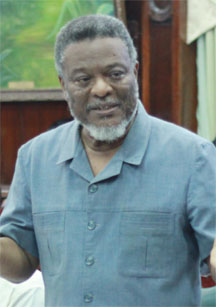The opposition’s chopping of $5 billion from the $10.2 billion allocated to the Guyana Power and Light Inc (GPL) puts the company in a precarious position and could leave government no option but to consider a tariff increase, Prime Minister Sam Hinds has said.
Speaking at a press conference at the studios of the National Communications Network (NCN) yesterday, Hinds said, “I am perplexed by the actions of the opposition parties… What are we going to do now? I am open to suggestions,” he said to reporters.
Last year, the opposition had also cut GPL’s budgeted allocation. And the sum remaining this year is close to what GPL would have operated with last year.
From the $6 billion sought in the 2012 budget, the opposition had lopped off $1 billion. Shortly after that budget was passed, GPL Chairman Winston Brassington had said that the $1 billion budget cut would have an impact on the company’s ability to hold to its current tariff – in the light of sustained increases in fuel prices – and to do maintenance.
He had projected that maintenance would be the first thing to be affected and that the company’s investment programme would also take a hit.
During the sitting on Thursday, the House in Committee of Supply slashed the $10.2 billion allocated to GPL by $5 billion.
During the presentation of the proposed budget, Finance Minister Dr Ashni Singh had stated that in the absence of tariff increases, last instituted in 2007, government was injecting $5.8 billion to support that company in meeting its cash flow requirements. In addition, he said that $5.4 billion was also budgeted to be transferred to GPL to support key projects such as the upgrade of its transmission and distribution network, the loss reduction programme, and other activities required in anticipation of the Amaila Falls Hydropower Project.

“How is this shortfall to be met? It could be met in various ways, [such as an increase in tariffs, purchasing less fuel, or encouraging shareholder uptake],” Hinds lamented at the press briefing yesterday. He said for the last of the options, this would in itself mean that tariffs must be made economical.
Hinds said that even if the full $10.2 billion had been approved by the Committee of Supply, the company would need a further $4.7 billion to adequately address its fiscal needs. “GPL’s list of things that they really need to do is not totally funded. Even with the allocations that we have put, there is an additional $4.7 billion that would be needed,” he said.
Hinds said that from 2003, GPL had suppressed by a net $27.8 billion and over the last three years government had put in another $20 billion as investment in the form of loans for system upgrades to meet the rising demands. “That is $56 billion to GPL,” he stressed.
He said that since the company is foregoing some $6.4 billion, which he said is money which should have flowed from the tariff, GPL is constrained in its plans for other areas, like additional meters for new subscribers. “GPL may not have meters or cables because stores are suppressed, suppliers [are owed large amounts] and running capital is tight,” he said.
Hinds said that since 2003 government has put a total of $55 billion into GPL in terms of maintaining the current tariffs and investing in capital projects. He said that an economic tariff for GPL is about $75 per Kwh when at present it charges about $60 per Kwh.
The PM pointed out that since 1992, demand for electricity has risen from where it was – 33 megawatts – to 87 megawatts today.
Hinds said the 50 cycle to 60 cycle frequency conversion which he called a good initiative by the PNC government in the 1970s is ongoing. He said the non-completion of the frequency conversion exercise is one of the reasons for the blackouts being experienced.
Hinds said some of the money cut from the GPL allocation was for the Amaila hydroelectric project, which he said would bring down electricity generation costs significantly – by some 50 per cent. He said that with current production cost standing at around $50 per Kwh produced, with Amaila in operation the cost will be reduced to $25 per Kwh. “We need to get Amaila going,” he said. Hinds added that government is putting a total of US$80 million from the Guyana REDD Investment Fund (GRIF) – the funding component of the Low Carbon Development Strategy (LCDS) into the Amaila project.
“We have decided to forego our returns on that investment as a way to encourage the other investors,” Hinds said.
Hinds said that losses continue to plague the company and noted that commercial losses outweighed technical losses. He said that while technical losses amounted to 14 per cent, commercial losses stood at 18 per cent. Losses overall amounted to 31 per cent, down from 44 per cent some years ago.
Hinds also dismissed the assertion by the opposition that poor management was responsible for the plight of the corporation.





